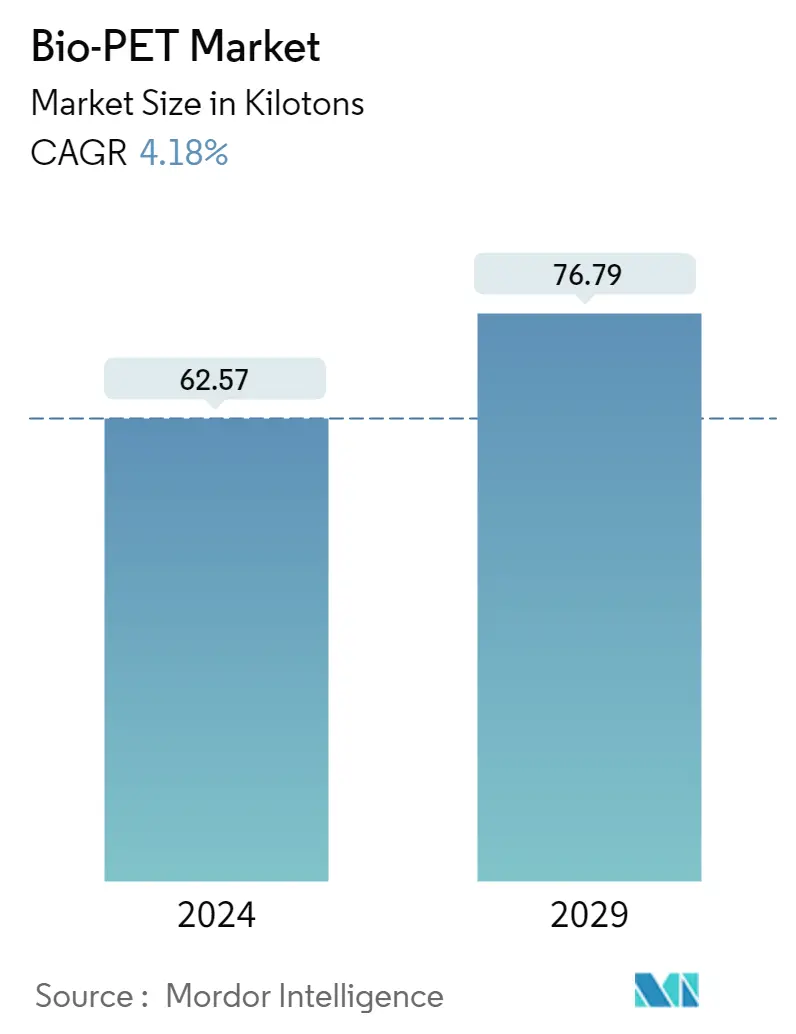Market Size of Bio-PET Industry

| Study Period | 2019 - 2029 |
| Market Volume (2024) | 62.57 kilotons |
| Market Volume (2029) | 76.79 kilotons |
| CAGR (2024 - 2029) | 4.18 % |
| Fastest Growing Market | Asia Pacific |
| Largest Market | Asia Pacific |
| Market Concentration | High |
Major Players*Disclaimer: Major Players sorted in no particular order |
Bio-Based PET Market Analysis
The Bio-PET Market size is estimated at 62.57 kilotons in 2024, and is expected to reach 76.79 kilotons by 2029, growing at a CAGR of 4.18% during the forecast period (2024-2029).
Due to the COVID-19 outbreak, nationwide lockdowns worldwide, disruption in manufacturing activities and supply chains, and production halts negatively impacted the market in 2020. However, the conditions started recovering in 2021, restoring the market's growth trajectory.
- One of the major factors driving the market studied is the growing GHG (Greenhouse Gases) emission concerns.
- However, the development of PEF (Polyethylene Furanoate) and a low melting point of bio PET is likely to restrain the market.
- Environmental factors encouraging a paradigm shift will likely boost the demand for Bio-PET during the forecast period.
- Focus on renewable sources is likely to act as an opportunity for market growth in the future.
- Asia-Pacific dominated the market across the world, closely followed by North America. Asia-Pacific is likely to witness the highest growth rate during the forecast period.
Bio-Based PET Industry Segmentation
Polyethylene terephthalate (PET) is a polymer used for different applications such as packaging, textiles, bottles, etc. The PET derived from natural compounds is called bio PET. The bio PET market report includes segmentation by application and geography. The market is segmented by application into bottles, packaging, consumer durables, furniture, films, and other applications. The report also covers the market size and forecasts for the bio PET market in 15 countries across major regions. The market sizing and forecasts for each segment are based on volume (Kilotons).
| Application | |
| Bottles | |
| Packaging | |
| Consumer Durables | |
| Furniture | |
| Films | |
| Other Applications |
| Geography | ||||||||
| ||||||||
| ||||||||
| ||||||||
| ||||||||
|
Bio-PET Market Size Summary
The bio-based PET market is poised for steady growth, driven by increasing environmental concerns and a shift towards renewable resources. The market, which experienced disruptions due to the COVID-19 pandemic, has been on a recovery path since 2021. Bio-PET, made from a combination of renewable and petroleum-based materials, is gaining traction as a sustainable alternative to traditional PET, particularly in bottling applications. The material's properties, such as being lightweight, transparent, and recyclable, make it an attractive choice for companies aiming to reduce their reliance on fossil fuels. The demand for bio-based products is rising, supported by consumer preferences and regulatory pressures to lower greenhouse gas emissions. However, challenges such as the development of alternative materials like PEF and the high cost of bio-PET may hinder its widespread adoption.
The Asia-Pacific region is expected to lead the bio-PET market growth, driven by its large population and high consumption of PET bottles. The region's expanding packaging industry, particularly in China and India, is a significant contributor to this growth. Factors such as increasing disposable incomes, lifestyle changes, and the rise of e-commerce are boosting the demand for packaged foods and beverages, which in turn supports the bio-PET market. Despite the high cost of bio-PET being a barrier, efforts by manufacturers to reduce prices could facilitate market expansion. The bio-PET market is partially consolidated, with key players like Coca-Cola, Indorama Ventures, and Toyota Tsusho Corporation holding significant shares. These companies are actively pursuing strategies to enhance their market positions, such as acquisitions and investments in recycling technologies.
Bio-PET Market Size - Table of Contents
-
1. MARKET DYNAMICS
-
1.1 Drivers
-
1.1.1 Environmental Factors Encouraging a Paradigm Shift
-
1.1.2 Growing GHG (Greenhouse Gases) Emission Concerns
-
1.1.3 Other Drivers
-
-
1.2 Restraints
-
1.2.1 Development of PEF (Polyethylene Furanoate)
-
1.2.2 Low Melting Point Hinders Usage in Some Applications
-
-
1.3 Industry Value Chain Analysis
-
1.4 Porter's Five Forces Analysis
-
1.4.1 Bargaining Power of Suppliers
-
1.4.2 Bargaining Power of Consumers
-
1.4.3 Threat of New Entrants
-
1.4.4 Threat of Substitute Products and Services
-
1.4.5 Degree of Competition
-
-
-
2. MARKET SEGMENTATION (Market Size in Volume)
-
2.1 Application
-
2.1.1 Bottles
-
2.1.2 Packaging
-
2.1.3 Consumer Durables
-
2.1.4 Furniture
-
2.1.5 Films
-
2.1.6 Other Applications
-
-
2.2 Geography
-
2.2.1 Asia-Pacific
-
2.2.1.1 China
-
2.2.1.2 India
-
2.2.1.3 Japan
-
2.2.1.4 South Korea
-
2.2.1.5 ASEAN Countries
-
2.2.1.6 Rest of Asia-Pacific
-
-
2.2.2 North America
-
2.2.2.1 United States
-
2.2.2.2 Canada
-
2.2.2.3 Mexico
-
-
2.2.3 Europe
-
2.2.3.1 Germany
-
2.2.3.2 France
-
2.2.3.3 United Kingdom
-
2.2.3.4 Italy
-
2.2.3.5 Rest of the Europe
-
-
2.2.4 South America
-
2.2.4.1 Brazil
-
2.2.4.2 Argentina
-
2.2.4.3 Rest of South America
-
-
2.2.5 Middle-East and Africa
-
2.2.5.1 Saudi Arabia
-
2.2.5.2 South Africa
-
2.2.5.3 Rest of Middle-East and Africa
-
-
-
Bio-PET Market Size FAQs
How big is the Bio-PET Market?
The Bio-PET Market size is expected to reach 62.57 kilotons in 2024 and grow at a CAGR of 4.18% to reach 76.79 kilotons by 2029.
What is the current Bio-PET Market size?
In 2024, the Bio-PET Market size is expected to reach 62.57 kilotons.

